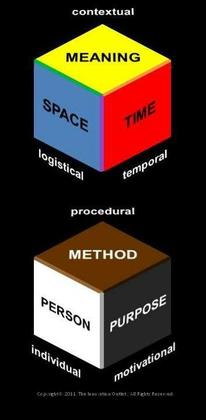About the clinics
Advancing Innovation Leadership through Creativity & Wisdom Work
The Katharine J Densford International Center for Nursing Leadership Creative Dialogue Clinics supports and inspires creativity through the application of creative strategies that support innovation leadership in education, practice, research, and project development. The clinic provides a time, place, and set of liberating structures and strategies for convening people to have creative conversations and receive consultation about innovative ideas, projects, challenging situations or issues.
The Creative Dialogue Clinics are facilitated by Dr. Daniel J Pesut, Professor of Nursing and Director of the Center for Nursing Leadership. Creative Dialogue Clinics will use Liberating Structures to facilitate group interaction, dialogue and discovery that supports innovative work. Liberating Structures (LS) are easy-to-learn microstructures that enhance relational coordination. They quickly foster lively participation in groups of any size and can replace more controlling or constraining approaches.
Clinics are free and open to the public.
If you plan to attend please RSVP to densford@umn.edu
Past Clinics
Wicked Problems
Addressing Wicked Problems in Health Care
Mastering Sense-Making Skills
Addressing wicked problems in health care demands uncommon skills. These skills can be learned. This workshop will provide health care leaders with specific groundbreaking sense-making processes drawn from 40 years of research and adapted by US intelligence gathering agencies, and useful for initiating and activating the best intelligence in organizations. The adaptations designed by Sagis’ Albert Linderman, Ph.D. brings individuals’ tacit, innovative thinking to the surface, making latent mental models explicit, allowing for quick alignment and the creation of an environment from which creativity and innovation emerges. This environment maximizes the best collective intelligence of organizations for the solution of wicked problems, organizational adaptation and sustainability. The workshop will provide learning opportunities for the mastery of sense-making leadership skills.
As a result of attending this workshop, participants will be able to:
- Explore and examine wicked problems in health care and associated leadership challenges.
- Apply Sense-Making Methods (SMM) to a health care or service delivery wicked problem in a selected organization.
- Practice the use of seven leadership questions and a listening strategy technique that surfaces mental models and provides knowledge about system issues, processes and dynamics.
- Develop a plan for using SMM as a leadership skill set to foster change, innovation and sustainability in health care organizations.
Keith McCandless
Advancing Innovation Leadership through Creativity & Wisdom Work

Making Sense of Wicked Problems in Health Care: Reflect, Listen, Learn
On June 11, 2015 the Densford Center sponsored a workshop featuring the Sagis Sensemaking work of Dr. Albert Linderman. Addressing wicked problems in health care demands sense making skills. Linderman and then Center Director, Daniel Pesut, facilitated the work shop. Participants learned how to use seven leadership questions and a listening strategy technique to surface mental models and of leaders and gain insight into the complexities of wicked problems (PDF) in health care.
Consider using the following questions to explore a wicked problem you are confronting:
- How do I see the issue (x)?
- What questions come to mind as I deal with (x)?
- What emotions do I experience as I deal with (x)?
- What paths forward or ideas have I considered about (x)?
- What decisions am I making now about (x)?
- What hopes or wishes do I have about (x)?
For answers to each of the above, what influences you to say that about the issue? Now imagine a facilitated conversation of a group of co-workers or organizational leaders who each shared their answers to the questions above and those listening were instructed to keep a listening journal that helps to make explicit one’s own mental models in regard to the issue at hand.
Questions that help surface one’s mental models include:
- What resonates with me / is like my own experience of this situation?
- What I hear that is new to me?
- How I see things differently and why?
- What is confusing and why?
- What would help the speaker?
Facilitating a discussion of combined listening journals provides valuable feedback to leaders and helps the group develop shared insights and understanding about the dynamics of wicked problems and the adaptive leadership to move issues forward. Through reflecting, listening and learning leaders gain insight and understanding that helps unravel the complexities of wicked problems.
Cubie™
Advancing Innovation Leadership through Creativity & Wisdom Work CUBIE™: The Innovation

As the complexity of health care and nursing escalates health care providers are challenged to think more creatively and develop innovations that advance the knowledge, learning, and service contributions of their discipline to the health care enterprise. It is important to activate the creative thinking skills of health care providers in order to re-design health care systems and improve patient care experiences.
Such activation raises the question: What does it really mean to “think outside the box?” Fortunately, for those of us who like tools and strategies and ways to flex our creative thinking mind set there are a number of creativity resources and technologies that help us realize all the dimensions related to thinking outside the box. Recently I became acquainted with the work of Charlie Garland, President of the Innovation Outlet and a Fellow of the Health Care Innovation Technology Lab at Columbia University Medical Center. Charlie has invented a tool that truly helps people “think outside of the box” and has also defined more specifically what it means to ‘think inside the box”. He has created the Innovation Cube which he calls CUBIE. Consider exploring this unique invention and consider how its use will help develop your thinking about thinking (metacognition and critical thinking) skills which are essential for innovation leadership. If you want to learn more about Charlie get access to a Slide Rocket Presentation or read this introduction to Cubie™.
Universal Safety Solution: Safety & High Stakes
Safety & High Stakes - Managing Threats & Errors: Lessons from the Field
Registration: The Clinics are free. Please RSVP to densford@umn.edu
The Densford Center at the University of Minnesota School of Nursing invites you to participate in our Creative Dialogue Clinic with Universal Safety Solution (USS):
Discuss the history, evolution and development of quality and safety initiatives in the airline industry.
Relate aviation quality and safety lessons to health care contexts.
Discuss principles for managing threats and errors.
Explain the value and necessity of partnership practice to quality, safety and innovation efforts in health care.
For direct Nursing application, see:
Time Out the Music is Too Loud
Sponsors:
Universal Safety Solution LLC
University of Minnesota School of Nursing
Creativity and Grit
Advancing Innovation Leadership through Creativity & Wisdom Work
Over the last few months several people have requested that we make some of the Creative Dialogue Clinics distance accessible. In service of this request, this late summer Creative Dialogue Clinic is provided for people to access and reflect on the relationship between creativity and an emerging concept that it getting attention in academic circles – GRIT – perseverance and passion for long term goals!
Nursing like many other Health Professions requires creative thought, innovative action and the grit to pursue long terms goals in service of a greater good. There is a need to resurrect and champion the teaching and learning of creativity technologies to support and augment the development of creativity and innovation in contemporary health care contexts among groups, and teams in organizations. Activation of creativity requires GRIT!
As the complexity of health care and nursing escalates health care providers are challenged to think more creatively and develop innovations that advance the knowledge, learning, and service contributions of their discipline to the health care enterprise. It is important to activate the creative thinking skills of health care providers in order to re-design health care systems and improve patient care experiences.
Listen to what Dr. Duckworth has to say about her research and reflect on the relationship of GRIT to creativity, innovation and the successful pursuit of long term goals. Consider taking Angela Duckworth’s GRIT Assessment to determine your level of Grit. How do insights about GRIT influence your thinking about your own creative aspirations? People who are committed to innovation leadership and the design of new programs, services, models or environments need a large dose of GRIT – to enable them to follow through on their commitments and aspirations.
Creative Self Perception and Creative Confidence
Inspiring Innovation Leadership through Creativity & Wisdom Work
Nursing requires creative thought and innovative action in service of the greater good. There is a need to resurrect and champion the teaching and learning of creativity technologies to support and augment the development of creativity and innovation in contemporary health care contexts among groups, and teams in organizations. Activation of creativity requires creative confidence.
As the complexity of health care and nursing escalates health care providers are challenged to think more creatively and develop innovations that advance the knowledge, learning, and service contributions of their discipline to the health care enterprise. It is important to activate the creative thinking skills of health care providers in order to re-design health care systems and improve patient care experiences.
Such activation raises the question: To what degree do individuals perceive themselves as creative? And to what degree do you appreciate your own Creative Confidence. Consider what David Kelly has to say in this video about the importance of Creative Confidence. After you have a chance to listen to this clip consider how the description about design empathy and creative confidence influences your thinking, planning and doing in the context of your work. Begin to appreciate your own creative confidence and learn more about it by exploring the resources at IDEO. How can you inspire creative confidence in your self and others where you live and work?
About the Presenter
David Kelly, Founder of IDEO